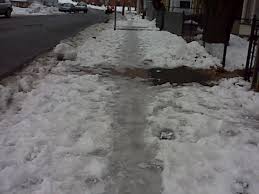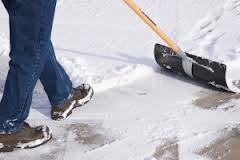
Walking Safely
When winter arrives, that means there is a potential for freezing temperatures, snowstorms, icy roads, and slippery sidewalks. During the winter months slip and fall responses increase, significantly. It is important for everyone to be aware of these dangers and to learn to walk safely on ice and slippery surfaces.
- Be alert for ice-covered areas, approach with caution and assume that all wet, dark areas on pavements are slippery and icy.
- Wear boots or shoes with grip soles, avoid boots or shoes with smooth soles and heels.
- Wear a heavy, bulky coat that will cushion you if you should fall.
- Use special care when entering and exiting vehicles, use vehicle for support.
- Walk in designated walkways as much as possible.
- Watch where you are stepping and go slow.
- Don’t carry or swing heavy loads, such as large boxes, brief case, or purse that will cuase ou to become off balance when you are walking.
- Don’t walk with your hands in your pocket. This reduces the ability to use your arms for balance if you do slip.
- Extend your arms out to your sides to maintain balance.
- Point your feet out slightly like a penguin, this increases the center of your gravity.
- Take short shuffling steps if very icy.
- When walking, curl your toes under and walk as flat-footed as possible.
- Place your full attention on walking. Digging in your pocketbook or backpack while walking on ice is dangerous.
- If you do fall, try to avoid falling on your knees, wrists, or spine. Try to fall on a fleshy part of your body, such as your side.
- Try to relax your muscles, if you fall. You’ll injure yourself less if you are relaxed.

Snow Shoveling
While snow shoveling can be good exercise, it can also be dangerous for those who take on more than they can handle. The potential for an injury is high, whether you use a shovel routinely or only once or twice a year.
Following are some tips for safe snow shoveling:
- If you are inactive and have a history of heart trouble, talk to your doctor before you shoveling.
- Avoid caffeine or nicotine before shoveling. These are stimulants, which may increase your heart rate and cause your blood vessels to constrict.
- Drink plenty of water.
- Warm up your muscles by walking for a few minutes in place, because warm muscles will work more efficiently and be less likely to be injured.
- Use a proper snow shovel, one that feels comfortable for your height and strength.
- Space your hands on the tool grip to increase your leverage.
- Push snow instead of lifting it, but if you must lift, squat with your legs apart, knees bent and back straight. Lift with your legs, without bending at the waist.
- Scoop small amounts of snow into the shovel and walk to where you want to dump it, carry too much weight is not good for your spine.
- Shovel slowly to avoid placing a sudden demand on your heart. Pace yourself and take breaks.
- Do not throw the snow over your shoulder or to the side. This requires a twisting motion that stresses your back.
- Listen to your body. Stop if you feel pain.

Snow Blower Safety
- If the blower jams, turn it off.
- Keep your hands away from moving parts.
- Do not drink alcohol and use the snow blower.
- Never let children operate snow blowers. Keep children 15 years of age and younger away when snow blowers are in use.
- Be aware of the carbon monoxide risk of running a now blower in an enclosed space.
- Refuel your snow blower when it is OFF, never when it is running.
- Do not remove safety devices, shields, or guards on switches.
- Understand your machine. Read the instruction manual prior to using. Be familiar with the specific safety hazards and unfamiliar features.
Sources: National Safety Council (nsc.org) and American Academy of Orthopaedic Surgeons (aaos.org)
